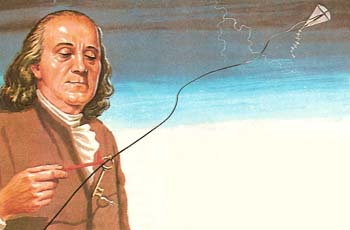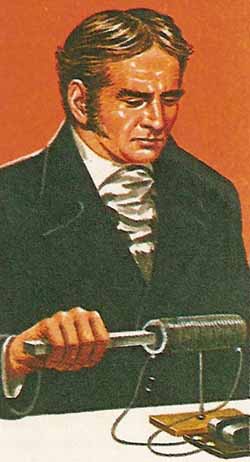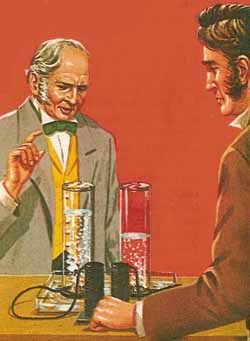history of electricity

Franklin drew 'electric fluid' out of a thundercloud.

Galvani's discovery of 'animal electricity'.

Faraday showed that a coil of wire can behave like a magnet.

Carlisle and Nicholson discovered electrolysis. An electric current (from a Voltaic pile) decomposed acidified water into hydrogen and oxygen.

Edison and (left) the electric bulb and (right) the electric generator.
Over 2,000 years ago, the Greeks discovered that amber rubbed with fur attracts light objects, such as dust or feathers. Two rubbed amber rods were found to repel each other. But the reasons for this were not understood. William Gilbert, re-reading the work of the Greeks in about 1600, was more interested in magnetism (he suggested that the Earth behaved like a gigantic magnet). He realized, however, that the attractive and repulsive forces between rubbed rods were very similar to the attractive and repulsive forces exerted by naturally occurring magnets. Gilbert named the new field of study "electricity," a word derived from the Greek word for amber.
In the course of time it was found that many other substances besides amber could produce electrical effects. Otto von Guericke, in the seventeenth century, made a large ball of sulfur which he could rotate with one hand and rub with the other. Apart from being able to attract small pieces of paper, it (rather unexpectedly) produced a crackle and minute sparks in the process of rubbing. For the first time it was seen that electricity could flow – in fact it was thought that electricity was some kind of fluid which could be transferred from one object to another by rubbing.
Guericke's sulfur ball device was widely used and developed by early scientists. It was one of the first methods of producing electricity. Later it was discovered how, having made the electric "fluid," it could be stored in a Leyden jar – a bottle partly filled with water with a metal chain hanging down through a cork in the bottle neck. This was the forerunner of the capacitor.
Benjamin Franklin saw the connection between the tiny electric sparks from a sulfur ball and the huge sparks of lightning – they were both flows of electric "fluid." He proved his point in his famous experiment where the moist cord from a kite flying in a thundercloud conveyed the electrical charge in the thundercloud to earth.
The Italian Galvani made another important, though accidental, discovery toward the end of the eighteenth century. He found that wires of brass and iron in contact with the leg of a recently killed frog made its muscles contract, as they contracted when the store of electricity from a Leyden jar was passed through the leg. Galvani thought that the leg had, in some mysterious way, produced electricity on its own.
There was very little in the electrical studies of the time of any significance. Electricity was regarded rather as a toy, to attract or repel or make sparks. Indeed the tiny amounts of electricity made by friction machines were of no practical use. Nearly all of our present-day knowledge of electricity has been learned during the past 200 years.
Alessandro Volta's discovery, in 1799, of the simple electric cell marked the turning point in the study of electricity. He showed that the muscular contraction of the frog's leg observed by Galvani had nothing to do with the frog itself, but was caused by the brass and iron wires in contact with the salty moisture in the legs. In fact, they made a primitive form of electric cell. Volta made his own electric cell from plates of copper and zinc in a solution of salt. He went on to construct a more useful battery (or pile as it was called) by joining a number of cells together.
The first important effect of the electric current to be discovered was its ability to break up chemical compounds into their elements, or electrolysis. At the beginning of the nineteenth century two English chemists, Carlisle and Nicolson, connected the two ends of a Voltaic pile to two platinum wires in tubes containing dilute acid. Bubbles rose from the wires and it was found that those from one wire were composed of oxygen, while those at the other were hydrogen. The chemists concluded correctly that the water had been decomposed into the elements which built it up, by the electric current.
With Volta's cells electricity could now be made easily and continuously. Scientists everywhere seized on Volta's discovery and used his cells in their own experiments. One of the great difficulties they encountered was that there was no method of measuring electricity. Until 1820 the only electrical measuring instruments were based on attractive and repulsive forces between stationary charges and were no use for measuring currents of electricity.
In 1819 an entirely knew aspect of electricity became apparent. Since the days of Gilbert it had been thought that electricity and magnetism were in some way related. When Hans Oersted deflected a magnetic compass needle by a placing a wire carrying an electric current over it, he demonstrated the nature of this relationship – a wire carrying an electric current behaves like a magnet. Oersted went on to prove, in 1820, that the wire becomes surrounded with a magnetic field. André-Marie Ampere followed this discovery with a wonderful series of experiments through which he was able to demonstrate completely the laws of force between wires carrying current. Since the forces obeyed laws, and the greater the current, the greater the force it exerted, this effect could be used for precise electrical measurements – it is the principle on which the galvanometer, and most ammeters and voltmeters are based. Electricity became for the first time an exact science. Georg Ohm and later, Kirchoff were able to state the relation between current, voltage, and resistance in a circuit.
Michael Faraday was the next important electrical discoverer. He quickly followed Oersted's work, using large coils of wire to make powerful electromagnets. With these Faraday was able to make the first simple electric motor. The forces acting between two coils of wire, one fixed and one movable, would make the movable one rotate.
It next occurred to several scientists that if an electric current could produce a magnetic effect, the reverse ought to happen, and a magnet could be used to make a current. For ten years Faraday looked for this effect until at last he managed to show how a changing current in one wire can produce a current in a neighboring wire. This effect is known known as electromagnetic induction. Faraday's discovery led directly to the dynamo, or generator principle – when a coil of wire is made to rotate in a magnetic field a current is generated in the wire. Thomas Alva Edison, the American scientist and inventor, developed this concept and built an electrical generator capable of making far larger currents of electricity than Volta's simple cells.
It was now obvious that electricity in motion was a form of energy. In fact the electrical generator was a way of converting mechanical energy into electrical energy. A wire carrying current becomes hot because electrical energy is being converted by the resistance of the wire into heat energy. This is the basis of all forms of electrical heating appliances. Humphry Davy found that electricity could also be used to make light. He connected the terminals of a large battery to two pieces of charcoal just separated from one another, and made a brilliant white light, the first arc lamp. Edison pioneered the modern light bulb by passing a current through a thin carbon filament enclosed in a glass bulb, and making it glow white-hot.
By 1850, practically all the important electrical effects had been discovered and explained. There were two major exceptions. One of these was the existence of electromagnetic radiation. James Clerk Maxwell started from a series of mathematical equations, and he showed that waves, electromagnetic disturbances, are associated with all changing currents of electricity. Twenty-four years later, in 1887, Heinrich Hertz, the German physicist, actually made and detected these waves. This discovery led to the idea, developed extensively by Gugielmo Marconi, that electromagnetic waves could be used to transmit messages, without wires, through the air. They were first used to send telegraph signals, over large distances, and, in the twentieth century, to broadcast sound and vision signals.
The question of what electricity was, and what actually flowed round an electric circuit was not answered until 1897, when J. J. Thomson discovered the building block of electricity, the electron. He deflected an electric current flowing through a vacuum, using a strong electric field, and, by seeing in which direction the beam was deflected, proved that it was made up of tiny negative electric charges, or electrons. Robert Millikan, in 1911, showed that the electron carried the smallest amount of charge possible. The tiny particles, which are present in all matter, could be distinguished by the amount of electricity they carry.


